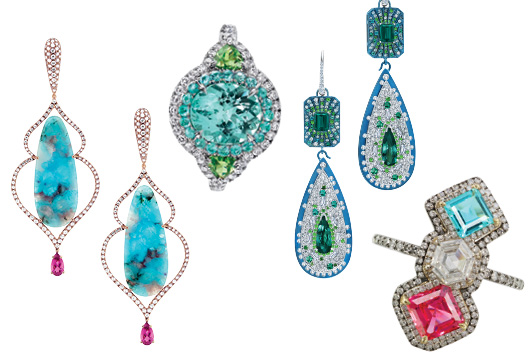
Three years ago, big jewelry houses laughed at Sam Sulimanov, owner of Samuel Sylvio Designs in New York City, when he tried to persuade them to purchase Paraiba tourmaline. The reason? The merchants did not sell “semi-precious stones,” he recollects. A year and a half later, Sulimanov was the one laughing. They called him asking for a pair of Brazilian ovals for a client and were shocked at the price. “They just didn’t know what it was,” he says.
Brazilian brillianceToday, many know about Paraiba tourmaline. Its distinctive “Windex blue” and “Scope green” colors — which no other tourmalines exhibit — result from traces of copper and manganese. The stone gets its name from Brazil’s Paraiba state, where it was initially found, but there are also deposits in Mozambique and Nigeria.
“It is a generally accepted term that material from both Brazil and Africa are called paraiba, but it’s a preference of people in the industry how they describe it — with a capital ‘P’ or not,” says Doug Hucker, CEO of the American Gem Trade Association (AGTA). He adds that his group has no rules for the stone’s nomenclature (see box).
Some gemologists say this tourmaline variety is rarer than pink diamonds, and because of limited availability, its prices have skyrocketed. The asking price for an oval-shaped, 4.61-carat rock of Paraiba origin is $150,000 a carat, according to Stuart Robertson, research director at trade publication GemGuide in Glenview, Illinois.
“I have not seen a non-Brazilian stone hit that vibrant, electric neon intensity of color,” he says. “The Mozambique stones are attractive, but they trade below the price of Brazilian stones.”
Los Angeles-based jewelry designer Victor Velyan uses a lot of Mozambique tourmaline — also called cuprian elbaite — in his high-end pieces because that’s what’s available. But he’ll also use Brazilian goods “every time I can get my hands on it,” he says.
Low supply, high demandThose occasions are infrequent, though, because very little new material is being mined.
“Supply is nil,” reports Bill Larson of Pala Gems in Pala, California. Larson was one of the first to deal in the material in the late 1980s, buying and cutting 22 pounds of rough, of which he sold 99% over five years. Early on, the Japanese bought up a lot of the goods, which were priced cheaply in comparison to today: $150 to $750 a carat.
Although Paraiba tourmaline still lacks the name recognition of the Big Three stones — ruby, sapphire and emerald — admirers continue to grow. Among them are working women who fear diamonds might attract the wrong sort of attention, according to Sulimanov: “Women with power who are afraid to wear a big diamond feel safe wearing Paraiba because nobody knows what it is.”
Still, the price tag can be an obstacle to ownership for many potential buyers. “Customers now are seeing prices that say, ‘Don’t buy me,’ even though the demand is there,” says Larson.
Image (left to right): samuelsylvio.com; omiprive.com; grazielagems.com; ivynewyork.comArticle from the Rapaport Magazine - October 2018. To subscribe click here.